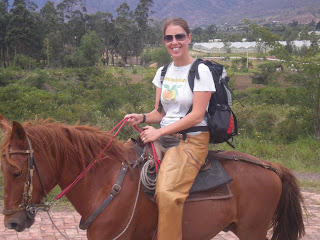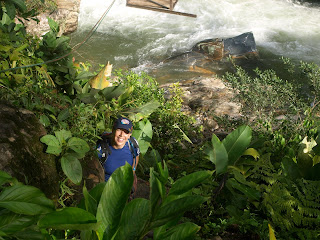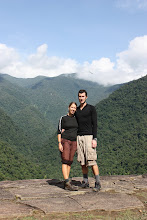Arriving at night in Bogota we did not get the best first impression of Colombia's capital city. After fighting our way through the hoards of security and people swarming the airport we headed by taxi to the backpacker area during which our taxi driver locked our doors as we drove through very dark, rubbish-strewn, run-down streets. We quickly found some accommodation noticing how many blankets there were on the bed and realising that we were facing cold temperatures for the first time in months.
Venturing out into the city the next day we found the local people of Bogota to be extremely friendly and helpful, although they constantly warned us of areas to avoid both day and night which added to the already edgy atmosphere of the city. We saw some incredibly poor homeless people and the cold temperatures made it all seem so much more hopeless for them, it was very sad to see.
We spent our few days there wandering around the old town, visiting the fantastic Botero Art Gallery where we saw works by Fernando Botero (the famous Colombian artist), Renoir, Dali, Monet and Picasso. We found a nice coffee and eating culture in the old town and noticed some very smartly dressed business people which were in total contrast to some of the poorer residents of the city.
After a couple of days we left Bogota and headed north into the countryside towards one of Colombia's best-preserved colonial towns, Villa de Leyva.
Villa de Leyva was a pretty town with a very lively atmosphere, particularly because there was a big festival going on and the local residents were celebrating by drinking beers day and night as well as setting off fire crackers continuously, starting at 4am in the morning. Needless to say, not much sleep was had whilst we we were there.
Whilst there we went on a horse riding tour into the countryside, they even found a horse big enough to carry Marc, although looking back at the photo's we realised that Marc's feet were almost touching the floor! Both us us really enjoyed the riding and are looking forward to doing more in Argentina.
Leaving Villa de Levya, after numerous trips to the local fantastic bakery and a trip to the hospital to get some medicine for Marc's poorly tummy, we headed for San Gil.
San Gil was also a very lively town, this time the Colombian's were celebrating their Independence Day so more street carnivals and beer drinking was a given.
We headed for the day to the beautiful Barachara where we did a short day trek through the canyon to a small village called Guane.
A few things we've noticed about the Colombians; they are really friendly and helpful whenever they can be, the women have a love of very tight lycra (too tight at times), they love drinking beer and they seem to cherish their pets unlike many other countries we've visited.
Heading on an overnight bus to Cartagena we arrived back into a hot climate. Whilst there we wandered the beautiful old city, eating really good food in a fantastic little German-owned restaurant, drinking on the square and getting offers of cocaine most places we went. There was a strong police/military presence there but they weren't threatening and actually made us feel safer (unlike the very scary Mexican police). We were really sad to leave Cartagena, it was a truly beautiful city with a really great vibe, a place we would highly recommend anyone to visit.
We got ourselves some pretty dapper hats whilst in Cartagena
We arrived after 5 hours in Santa Marta, which was quite a run down shipping port. It did not have a lot of appeal, so we were glad to be heading further along the coast to the small fishing port of Taganga. Taganga has a reputation of a hedonistic party town, but in reality this was confined to the weekends only. During the week the town was laid back and peaceful. There were lots of activities on offer and we had thought about taking on the Lost City trek before arriving in Taganga and were keen to find out if and when this would be possible. We organised a date to leave and met some of the people in our group and carefully planned what to take with us, as we would be carrying all our own stuff through the jungle for 5 days.
We met the rest of our group early on day one at the tour office and all jumped into a well used 80's Land Cruiser. We crammed 8 people into the truck and drove for about an hour through heavily manned military road blocks and armored vehicles, until we stopped for a drink and were told the road got a bit rough. Our man switched it to 4x4 and headed up some impossibly rough terrain with rutted areas which left us on two wheels on several occasions - 'Let's off-road'.
We got to the drop off point after about an hour and a half and stopped for some lunch. We were introduced to our team of Nicolas (pot bellied very content guide), Pollo (drunken guide, Pollo tranlates as chicken, or little chicken as his mates called him), Enrique (master chef) and Alexandra (helper and fastest walker of us all, in sandals all the way).
After lunch we began walking uphill for about 2 hours through deep mud. The group spread out quite a bit, but we all stopped to catch our breath at intervals. We finally reached the top of the hill and the heavens opened, as we expected nearing the entrance to the jungle. It was clear that keeping our clothes dry was going to be a fruitless task, considering we were soaked through after 10 mins of tropical thunderstorm. Our guide gave us fruit in the breaks, which was a real treat after the lung busting climbs.
We continued for another 2 hours until we reached the first camp, which was a cool place right on the river. It was raining, but we were all tired and soaking, but went in the river to wash off anyway. It was our first night sleeping in hammocks - how does anyone get any sleep in these things?
Day two and some of the group went off to see how cocaine was produced. We were interested to find out also as the local farmers all grew plants which they sold to the cartels, but they wanted $15 each for a guided tour, so we were not really prepared to promote this by paying for it. We finally set off walking around 9am and walked up and down through lush meadows and the beginnings of the jungle with amazing views of the valley. We got to the camp about 4 hours later just as the rain started after some waist deep river crossings and marching through the swarms of mosquitoes. We were greeted with a hearty bowl of chicken and vegetable soup and crackers rusted up by Enrique - he really knew how to look after us! We dried our feet and got into the dry clothes that we kept tucked away in our bags, which were an absolute blessing after a day of being wet through.
Another early night followed by an early start to get most of the walking done before the 'like clockwork' thunderstorm at 1pm.Day three we started to get deep into the jungle, with more river crossings, by foot and by high-wire cage, relentless mosquitoes and the largest insects I have ever seen. We saw snakes, giant toads, spiders and at one point I could not see the ground for insects under my feet. We stopped at a local village and were introduced to the local Kogi people and our guide explained how they use coca leaves and crushed seashells in their Poporos.
The poporos are given to the boys in the village to signify them becoming men at the age of 17. This means that they can start having a family with a local girl who is normally only age 14 when she falls pregnant with her first child. The older women in their 20's looked more like 40; they grow up pretty fast around these parts.
We took some packs of pencils to hand out to the local children
We arrived at around midday after 5 hours of scrambling over and around rocks, more river crossings and had some lunch at the third camp.
We camped next to the river again, which had an amazing waterfall, which we took turns to throw ourselves off - it was so refreshing after the days walking - the water clean and fresh so we had our bath in the river that afternoon. That night we all drank a cup of hot coca tea and nestled into our beds that smelled like smelly traveler.
Our rustic camp, and the rain kept on coming
Day four started with a breakfast of empanadas (bit like deep fried pasty) and coffee. We prepared a day pack, as we would be coming back to this camp later that day and headed over the river and up the 1200 steps to the Lost City.
We reached the first stage of the city and the air was full of insects, even worse than before. We took some snaps and headed further into the city, our guide giving us lots of detail on the significance of the various areas of the site. We reached a clearing at the top where the view over the valley and jungle we had trekked through was breath taking. We were relieved to have arrived with no major incident and basked in the sunshine, which dried out some of our sodden clothes. Nicolas reached inside his magic bad and gave us all lollypops, which was a surreal moment sitting at the top of the ruins, 4 days from any civilisation.
The butterflies were beautiful
After wondering around the city for a few hours, we knew we had to make it down for lunch as we had to start the long walk back. We picked our way down the steep steps and made it back to the third camp. After lunch we got into our nice dry clothes that had been hanging in the sun all morning and proceeded to head into a chest deep river which left me wondering why we bother trying to keep anything dry at all. We walked for about an hour and a half until, like clock work, the rain started. This time is was heavier than before and soon we were walking down paths that had become streams. The rain just kept getting heavier and heavier, until the streams became small rivers in a matter of minutes. Nicolas and the team had to stop at tricky points and help the group through as simple knee deep river crossings had become powerful rapids which kept getting more water added to them. After the precarious high wire cage crossing and scaling paths that had dissapeared into the river, we were glad to have made it to the second camp all accounted for. Not many of us had experienced such rain before and the river was full and angry looking - a slip into the river was not something to bear thinking about.
We later found out that the rain had been so fierce, it had caused a landslide which wiped out the sleeping area of camp three, where we had spent the previous night. We found out later once we returned to Taganga that many people in the group just behind us had to be evacuated via helicopter.
The final day we awoke to sunshine and the calm after the storm. We trekked for around 6 hours through the carnage of the storm, up and down hills, with bruised feet and aching joints. We finally arrived at the starting point at around 2pm - exhausted but relieved to have made it back - the beer tasted rather special I can tell you. As a group, we all went out to dinner together that night in Santa Marta.
Our trekking friends; exhausted but happy
After the trek we spent the next few days back in Taganga eating well and sleeping. It took 3 days to dry out our shoes and they still smell like rotting vegetables. We met up again with our Canadian friends from the trek and went diving with them and had a steak supper with yummy red wine; bliss.
Taganga
Monday, 16 August 2010
Subscribe to:
Post Comments (Atom)






















HI u 2! am in a hurry but had to read your report. Better late than....Marc are you not glad that you had riding lessons in Zell? Send a pic on face book. Love E
ReplyDeleteHi again, read your posting again, very exciting. A little bit more than to the 3 Brüder!
ReplyDeleteGlad you are safe back.
Lots of Love from the Austrians at home! E